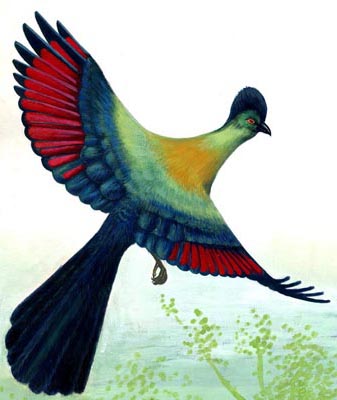The ENTC now has a new website, at www.entc.org.sz
Our logo is adapted from a painting by Phillip Dlamini, 1998, of a purple crested turaco. In traditional Swazi dress, the red feathers feature in the royal headdress, so this bird illustration is not only a symbol for wildlife conservation, but also of cultural heritage.


(Last update by Bob Forrester, December 2005)
The Swaziland Archaeological Research Association was active from 1977 to 1989. Working in close conjunction with the SNTC they excavated the Sibebe, Nyonyane and Siphiso rock shelters. The research was exclusively centred on the stone ages, trying to establish a chronology for them by using botanists, geologists and climatologists to supplement information from the archaeological excavation.
The team leader, Dr David Price-Williams, was Director of Antiquities in the SNTC. The group was the first in southern Africa to effectively use a multidisciplinary approach and much of the information gathered is now accepted theory.
During the 1990s research was carried out in the Komati valley by Prof Tom Huffman, this established a preliminary framework for dating the iron age. No further intensive countrywide research was carried out until the late 1990s when Fumiko Ohinata, working with the SNTC, established a detailed iron age chronology for the country as part of her PhD thesis for Oxford University. In 2003/4 J Masson and R Forrester surveyed all known rock art sites in the country and recorded them photographically.
The archaeological material excavated is housed in the National Museum storerooms, together with a collection of ethnographic and historical material. This is currently being recorded digitally and the information is being placed in a database.
This department is essential in order to prevent the loss of knowledge of the past through protection of archaeological sites and artifacts.
The objectives of the Archaeology Department are:
(a) to undertake research into the past (archaeological survey).
(b) to protect and preserve the country's archaeological artifacts.
Archaeological sites within SNTC's protected areas include the Lion Cavern, in Malolotja Nature Reserve, and the Siphiso Rock Shelter in Mlawula Nature Reserve.
Archaeological artifacts that have been preserved are housed in the National Museum.
A number of papers were published with regard to the archaeological work carried out.
Our Contacts:
Head Quarters: (+268) 2416 1489/1179
Email: info@sntc.org.sz
King Sobhuza II Park: (+268) 2416 1489/1179
Email: ksmp@sntc.org.sz
National Museum: (+268) 2416 1489/1179
Email: curator@sntc.org.sz
Copyright © ESWATINI NATIONAL TRUST COMMISSION
Malolotja Nature Reserve: (+268) 2444 3241 / (+268) 2416 1480
Email: culturalvillage@sntc.org.sz
Mantenga Nature Reserve and Swati Cultural Village: 2416 1151/1178
Email: culturalvillage@sntc.org.sz
Mlawula Nature Reserve: (+268) 2383 8885 (Reception)
(+268) 2383 8453 (Senior Warden)
Email: culturalvillage@sntc.org.sz
Magadzavane Lodge: (+268) 2343 5108/9
Email: magadzavane@sntc.org.sz